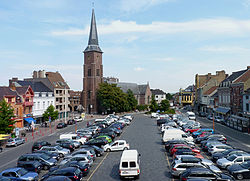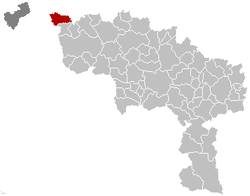Mouscron
|
Mouscron Moeskroen (Dutch) |
|||
|---|---|---|---|
| Municipality | |||
 |
|||
|
|||
| Location in Belgium | |||
| Coordinates: 50°44′N 03°13′E / 50.733°N 3.217°ECoordinates: 50°44′N 03°13′E / 50.733°N 3.217°E | |||
| Country | Belgium | ||
| Community | French Community | ||
| Region | Wallonia | ||
| Province | Hainaut | ||
| Arrondissement | Mouscron | ||
| Government | |||
| • Mayor | Alfred Gadenne (CDH)) | ||
| • Governing party/ies | CDH, PS | ||
| Area | |||
| • Total | 40.08 km2 (15.47 sq mi) | ||
| Population (1 January 2016) | |||
| • Total | 57,391 | ||
| • Density | 1,400/km2 (3,700/sq mi) | ||
| Postal codes | 7780-7784 | ||
| Area codes | 056 | ||
| Website | www.mouscron.be | ||
Mouscron (French: [mukʁɔ̃]; Dutch: Moeskroen, pronounced [muˈskrun], Picard: Moucron) is a Walloon city and municipality located in the Belgian province of Hainaut, along the border with the French city of Tourcoing, which is part of the Lille metropolitan area. The Mouscron municipality includes the old communes of Dottignies (Dottenijs), Luingne, and Herseaux (Herzeeuw). Mouscron is a municipality with language facilities for Dutch-speakers. Kortrijk, in Flanders, is located just north of Mouscron.
A few archaeological discoveries were made in this area proving the existence of settlements during Roman times. The name Dottignies – a village that is now part of Mouscron – appeared for the first time in the 9th century, while that of Mouscron itself appeared only in 1060. In 1066, Baldwin V, Count of Flanders ceded the local buildings and territories to the estate of the church of Saint-Pierre in Lille. In 1149 the right to collect tithes in the Mouscron area was ceded partly to the abbey of Saint Martin in Tournai, partly to the chapter of the Tournai Cathedral. The rights to the neighbouring villages of Herseaux and Luingnes – now also part of Mouscron – were also given to the Tournai cathedral in 1178. In the 14th century, the seigneury of Mouscron was eventually sold to a Tournai lord, and in 1430, the local castle became the lord’s manor, or Château des Comtes, which can still be seen today. The future Charles V, Holy Roman Emperor stopped there for dinner on May 27, 1516.
...
Wikipedia




